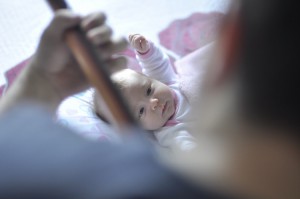
By Lela Nargi
“Because I’m a girl engineer, everyone always thinks I started this business with my husband,” says Jenny Young with a laugh that only vaguely disguises her frustration. An airplane pilot, a graduate of Purdue University’s mechanical engineering program and now, owner of Brooklyn Robot Foundry—one of the borough’s hippest destinations for the under-12 set—Young is, alas, no stranger to cross-eyed looks from a certain stripe of “traditionalist” who thinks that science is better performed by boys and men. And although she owns that women engineers are a definitely minority in the US, “For me, it’s not an issue,” she says.
This may be because of the strong and encouraging start she received from her parents growing up in Chagrin Falls, Ohio. “They were both very hands-on,” Young says. “My dad built a car from scratch, and the lawnmower, and the rototiller, so I was always with him in the garage, building stuff. And my mom makes all kinds of things with her hands.” For a while, Young thought she’d pursue a career as a pilot, then decided to focus on aerospace engineering instead. She moved to New York and began working for a software engineering company called Wireless Generation—where she met both her husband, Ken, a computer scientist, and her original business partner (now out of the picture), David VanEsselstyn, who works in education. And pretty quickly, she began to long for the various joys and liberties that come along with fabricating things on your own.
“It was hard not to have a workspace with all my tools in it,” Young says. “I needed that continuation of being able to build.” She joined an early, shared maker space in artsy East Williamsburg. And then, one fateful afternoon in 2012, she reserved time at a sewing studio further south, in the now gentrifying neighborhood of Gowanus, to stitch up little books for her pending wedding to Ken. She befriended the owner, who asked if she’d be interested in subletting the space. And Brooklyn Robot Foundry in its first incarnation—there’s now a second location in Manhattan’s Tribeca—was hatched.
Young’s own experiences—as an engineer, as a maker of things, and now, as a mom to 2-1/2 year old daughter, Adalina (son, Ero, is on the way)—heavily influenced the weekend, afterschool, and summer curricula she’s developed for toddlers through 7th graders (and sometimes adults). “The way I was raised in the Midwest, we were always taking things apart and asking questions,” she says. “We didn’t watch much television; we were doing things with our hands. It makes your brain work in a different way, and it makes you wonder, how does that work? If you don’t get that experience as a kid, you don’t think about those questions, and that’s a shame.”

A few years back, Young asked an early group of urban kid robot builders, “How does a stoplight work?” Their answers were funny—and slightly unsettling (one example: “There’s a mini Mickey Mouse in there!”). But under her and her assistants’ tutelage, says Young, “By the end of a week, they totally get how things work.” And they’ve learned simple construction and coding skills to boot.
On a recent summer morning, the Gowanus output of the Foundry was humming with tweens collaborating on a host of robot projects. “It’s a nice hum, though, isn’t it?” Young asked. “It’s the hum of people working who are doing things they enjoy.” The robots were being assembled by their excitable but focused overlords out of simple and often up-cycled materials like aluminum foil and cardboard boxes, and were attached by wires to batteries, servos, circuit boards, and laptops, and in some instances, such bells and whistles as LED’s, sound and motion sensors. They included at least two candy dispensers, a mousetrap, and a maze for racing homemade hexbugs and they were being (mostly) patiently programmed using a language called CREATE Lab Visual Programmer, created at Carnegie Mellon.
Surveying the scene, Young smiled—and continued to smile, ever wider, as she visited worktables and asked and answered questions. “Kids are so much more creative than we are,” she said. “[Adult] people ask me, Why don’t you do Lego robotics? But that’s expensive, and I want kids to know, this is a motor that costs a couple of bucks at RadioShack, this is a gearbox. And you can make anything you want out of whatever you’ve got around, because you have the confidence and the ability.”

The assembled group included some girls—not the almost 50 percent Young can see among younger classes of participants, but somewhere closer to 25 percent. Like female scientists before and concurrent to her, Young is baffled by how, not to interest girls in STEM topics in the first place, but to keep them interested and engaged as they get older. “When it comes to the gender breakdown, the thing I find most disturbing is that the numbers tank around second grade. We’re hoping that as we’re here longer, we can get them excited and keep them longer. I really think you have to catch them young and show them how cool these things can be. That’s how you get them to come with you. I hope.”
Young’s also been doing concerted outreach toward both girls and their parents, with a, women in tech lecture series, meant to act as a sort of sampling of the diverse and fascinating panoply of STEM-related jobs that real women have; and a girls club where parents and daughters can come in and build together. Nevertheless, “We don’t do specific projects for girls,” she says. And perhaps steering clear of this sort of restrictive thinking will help Young yield significant changes in attitudes about girls in math and sciences, as well as how they should act and behave. “I’m an engineer, and I was also a princess for every single Halloween growing up,” she says. “We give them the base of understanding about how to turn components into, say, a crane. Then, if they want to make it look like a princess, we don’t care! We just want them to understand that it’s cool to build.”
Photographs by Roy Beeson


